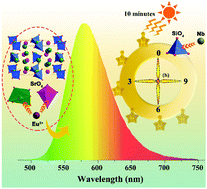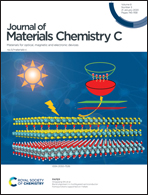Sunlight-activated yellow long persistent luminescence from Nb-doped Sr3SiO5:Eu2+ for warm-color mark applications†
Abstract
Warm-color persistent luminescent materials are strongly desired for signage markings and medical imaging in comparison with green or blue counterparts. Herein we report a novel yellow long-persistent phosphor, Nb-doped Sr3SiO5:Eu2+, with a peak wavelength of ∼580 nm and persistence time of more than 14 hours at the 0.32 mcd m−2 threshold value after UV radiation. A combination of thermoluminescence (TL), thermoluminescence excitation (TLE), electron paramagnetic resonance (EPR) measurements and density functional theory (DFT) calculations reveals that the persistent luminescence enhancement is attributed to a significant Nb-induced increase of oxygen vacancies that act as electron trapping centers with appropriate trap depths. Groups of time-dependent color-change images are realized with this material, which has potential applications as anti-counterfeit and indicator marks. This investigation also expands the application of transition metal (TM) ions to the field of persistent luminescence and would motivate further exploration of TM substitutions to design and improve silicate or aluminosilicate persistent phosphors with superior performance.



 Please wait while we load your content...
Please wait while we load your content...